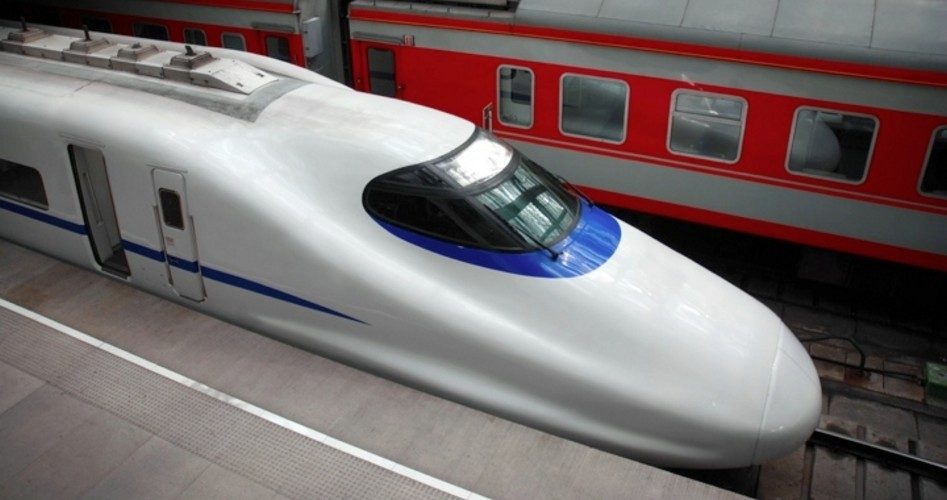
After enduring a series of financial and logistical hiccups, California’s landmark high-speed rail project has become increasingly unpopular among voters, as the project’s enormous price tag continues to inflate and as the state’s budgetary woes grow more severe.
Without a concrete plan for funding, supporters of the state’s high-speed rail project pitched a revised proposal in April to lawmakers and the general public. Due to severe budget constraints, the updated plan narrowed the scope of the project while speeding up construction to save money. Furthermore, about $1 billion in voter-approved bonds will be available to revamp existing tracks, which will purportedly make rail service more efficient and potentially bring in more customers. In a previous article, The New American reported on the revised proposal:
The newly minted plan expedites completion of the first true U.S. high-speed rail system, moving it to 2028, trimming the project timeline by five years and shaving $30 billion off the original budget drafted last year by the California High-Speed Rail Authority. In 2008, when residents first voted to authorize the bonds, they were told the overall cost of the project would be $45 billion — and four years later, the total became $98 billion. The new proposal has reduced that number to $68.4 billion, still $23.4 billion more than the original total.
However, despite the purported cost savings, the rail system still relies heavily on shaky federal funding and speculative private-sector investments. “We’ve seen numbers in the $30 billion, $40 billion, the $90 billion range, and now we’re back in the $60 billion range,” Sen. Joe Simitian (D-Palo Alto) said at the time. “I think there is understandably both some confusion and skepticism about what is the system going to cost, and then there’s the question of where is the money going to come from?”
Due to such uncertainty, voters in the state are turning on the project, as a new poll conducted by USC-Dornsife and the Los Angeles Times found that 55 percent of California voters want the $9-billion bond issue — which was approved in 2008 to fund early stages of the rail system — back on the ballot. And a startling 59 percent affirmed that they now would vote against it.
While labor unions have been staunch supporters of the project, a sizable 56 percent of union households now oppose the funding plan, the poll added. Even Democrats, the project’s most prominent supporters, have become skeptical, as 47 percent now reject the bond issue. The Times explained that revenue projections and overall use of the high-speed rail are also in question:
The poll found that most voters don’t expect to use it. Sixty-nine percent said they would never or hardly ever ride it. Zero percent said they would use it more than once a week. Public opinion surveys cannot predict the revenues and ridership a rail service might generate. The poll results raise questions about whether the system would serve as a robust commuter network, allowing people to live in small towns and work in big cities or vice versa. On the other hand, 33% of respondents said they would prefer a bullet train over an airplane or car on trips between L.A. and the Bay Area.
Since voters approved the $9-billion borrowing scheme, the state’s economic condition has become bleaker, and many initial promises about the rail line have been altogether abandoned. The estimated cost has nearly doubled, and it is now scheduled to share track with freight trains and slower commuter trains in certain areas, which will severely hamper the very intent — that is, speedy and efficient transportation — of the project. Moreover, agriculture groups and freight rail lines have warned that the routes would compromise their interests; schools, businesses, and homeowners have also voiced their concerns over the project.
Last Friday, farm groups filed an environmental lawsuit in Sacramento County Superior Court, requesting a preliminary injunction to halt rail construction. This suit has been added to a growing list of other filings, and more agricultural interests are threatening suits as well. “We think a preliminary injunction against construction will occur because there were so many violations in the authority’s environmental impact report,” stated Anja Raudabaugh, executive director of the Madera County Farm Bureau.
“California voters have clearly reconsidered their support for high-speed rail,” said Dan Schnur, who directed the USC Dornsife/Times Poll. “They want the chance to vote again — and they want to vote no. The growing budget deficit is making Californians hesitant about spending so much money on a project like this one when they’re seeing cuts to public education and law enforcement.”
The public has become even more skeptical of the high-speed rail line as Gov. Jerry Brown has threatened severe cuts in education spending — among other public programs — due to the state’s expanding budget gap. “The growing budget deficit is making Californians hesitant about spending so much money on a project like this one when they’re seeing cuts to public education and law enforcement,” Schnur noted. “But they also seem to be wary as to whether state government can run a big speed rail system effectively.”
Photo: modern express train and classic trains inside the station via Shutterstock



